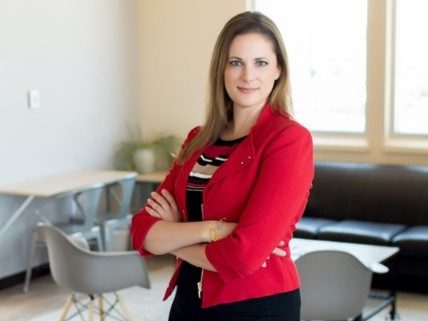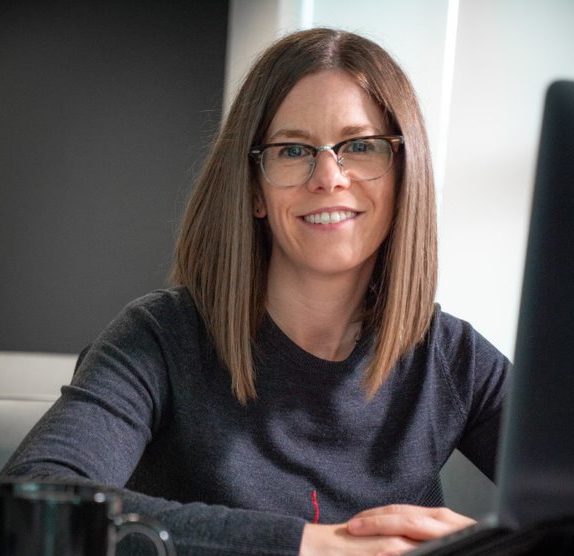Create tomorrow’s workplace better for everybody
Scott Burns is the CEO and co-founder of Structural now, but this isn’t his first time building a business from the ground up. At his last company, which he started in a basement, Scott took his workforce from 0 to 250. It wasn’t an overnight success, he says. In fact, it took him 15 years to get there, while opening offices across the US and an international office in Europe.
During the 15 years he spent at his last company, Scott built an appreciation for something many of us may not have an eye for–the ability to connect people to internal opportunities within their organization.
Along the way, Scott developed frustration with the lack of good technology to improve people’s work experience and internal connectivity.
Technology these days
In today’s world, the benefits technology can provide to businesses may seem obvious. We see it day to day in how it connects us to each other in ways we never before thought were possible. But, Scott is unconvinced about the application of technology in making our personal and work lives better like it should. While it’s great that technology connects us all in a matter of seconds, it’s defined efficiency as getting twice as much done in three times more effort.
That said, Scott is confident the role of technology is poised to add tremendous value in your workspace by making it work for you.
Three principles to make the future of work better for you
Scott has identified three frameworks for conceptualizing his technology embraced workplace model.
- Technology should empower the individual
- Put network over hierarchies
- Bring opportunity in the work experience
Technology has given us a chance to solve many disconnected issues that we faced in the past. More importantly, to solve them in a new way. Technology is an enabler of a better future. But here’s the important thing—
“Technology should serve us; it shouldn’t be running the show.” Scott Burns
Networking where you work
It’s important to invest in fostering networking within the company. Incorporating the value of a network into any job has a lot of value. That’s precisely what Structural was created to foster.
Structural is like a powerful internal LinkedIn. Large companies often face the challenge of learning who’s capable of what, who’s doing what, and who wants to do what. These are missing pieces in an employee’s profile that others in the org can access before a meeting or while talent scouting within the company.
It’s necessary that companies empower their people to network and make connections they need to team with others quickly and get things done. This provides the internal opportunity for people to take on a new project or role, without having to look elsewhere for a transition.
So ask yourself—
“Do your employees have more opportunity inside your company or outside of it?” Scott Burns
Recognizing the importance of experiential learning
Experiential learning, says Scott, is an important part of what your business offers an individual. Millennials and Gen Z now entering the workforce value experiential learning because it’s easy to access new information and apply it immediately.
Services like YouTube help solve problems instantly that new-age workers find studying MBA for two years less attractive. Organizations must put a strong emphasis on experiential learning and integrate it into their business and community to empower young and older individuals to grow and develop in their own way.
Positive work culture ≠ a ping pong table
People have the wrong idea when it comes to creating a workplace culture. It’s become offerings like a ping pong table and an internal message board where people post cool pictures. They aren’t bad ideas, but they’re not the way forward.
Scott strongly asserts that improving the employee experience and digital work-life is by enabling people with the right technology. Organizations must make conscious decisions to empower their workforce to not only do their job better but to continuously draw experiences from work and keep improving.
“The #1 thing to drive up the employee experience is for them to be successful individually, and to be a part of something successful.” Scott Burns
Links
Today, we are happy to bring on Scott Burns. He is the CEO and cofounder of Structural. Hi, Scott. How are you doing?
Great. It’s great to be here. Thanks for having me.
Always happy to have you on. We had a conversation before this a little bit ago. I’m so excited about the ideas you have about the digital workplace, where people are going with this, but why don’t you give a little bit of background for the folks?
I’m the CEO and cofounder of Structural, as you said, and we really put our platform together based on experience that I had building my last company. My last company, we started in the basement. We built it to 250 people. It wasn’t an overnight success, took maybe 15 years to get that done. We also got to experience a lot of changes in doing that. We had the generational change where millennials became the majority of our workforce in 2009. We had an international office in Europe, that was very successful. We started in Minnesota, but we had offices in New York and California, in Wisconsin, and a big office in Washington, DC. And given all of that experience, I built an appreciation for how much you can get done if you really connect with people inside your organization to the right opportunities at the right time. But I also developed a lot of frustration with the lack of good technology for helping improve the work experience for people and the connectivity they had. And so when I left that last company, we sold it actually, we launched Structural and the whole goal is to make the future of work better for everybody.
So that’s great. It’s what we’re all about, making the future of work better. We’re specifically going to talk about technology today and how technology and data can actually make people’s work better. Maybe many years ago, we thought, okay, technology just adds complexity, or maybe it helps in some processes, but day to day operations may make it more frustrating. But walk us through, you have like this framework of the three principles that you follow when it comes to using technology in companies and how to make it better into the future of work. So walk us through those.
I think that’s really important the way you describe that. There’s a lot of different ways people think about technology. And the negative ways are technology is going to automate everything and take our jobs and those sorts of things. And there’s also this day to day experience people have where, in a lot of ways, the technology that we’ve been given has defined efficiency as like getting twice as much done in three times more effort. We’re all checking messages all day, we’re connected all the time. And that’s a great contribution of technology. But I’m not sure that it’s taken life and work and opportunity up a level like it can. And so the three principles we start with, it’s number one, making sure that you’re focused on technology that empowers the individual. And that empowering the individual is really a cornerstone of the employee experience that you deliver through technology, through culture, through other things. The second piece for me that’s just incredibly important is putting networks over hierarchies. What I mean by that is really tied to that empowerment principle. It’s that individuals should be able to make the connections they need to get the job done, they should be able to team with others quickly, they should be able to navigate the organization in a really fluid way. And I think we all know from our professional job searches on LinkedIn, from Facebook, from Twitter, from Instagram, from whatever we’re using to connect with others, that a network is stronger than a hierarchical or siloed relationship. I think that companies just need to invest in fostering those networks. And then the third thing for us is really making sure that you’re bringing opportunity into the work experience and embedding it everywhere. And what I mean by that is that if you’re like a Gen Z, those people that are just entering the workforce, the post millennials, or a millennial, or really anybody in a job.
Or a human.
The old concept of, hey, put in your time, work here and you might get a promotion later, is just extremely dated and out of touch with the reality that an individual really wants to see opportunity every day when they’re working. What we’ve really worked on is making sure that whatever we deliver to our clients helps them promote opportunities everywhere, not just new jobs, but opportunities for experiences, for contributing to the company, for participating, for learning, for mentoring. And if you get it right, if you empower people, you put the networks over hierarchies and you embed opportunity, great things start happening really quickly because employees want all of these things.
Yeah, I think this is the vision for the future of what it means to offer an engaging environment for employees so they step right away, and they see, hey, I’m valued here. The kind of work I’m going to bring is going to be credited here. Let’s take one step back, we were talking about technology in general. And I think it seems like from what you were saying, we all have this healthy skepticism of technology that, yeah, it’s good for these things, but watch out for this other stuff that’s there. And I feel like most of us walked into at least 2020 with those feelings. And we had the ability to keep technology at arm’s length for the most part. Some people are invested in it totally in their jobs, but some people, the average employee could have their work life and then have their technology life semi separate, even though most of their work is digital. But now we’re in a place where so many teams are remote or distributed. And it’s like, okay, now we’ve got to look beside us and realize, hey, technology’s here and it’s with us for the long game. And we’re going to be partners going into the future. So as we implement these principles, which we’ll walk through in a bit, what is a healthy way to look at technology? Do you have a metaphor that we can have or a way to look at what should that relationship be like as we go forward?
I think it can feel a little bit cliche. But in my last company, we were working with governments and we were helping them do better digital communications and better digital marketing. And a lot of times, if that’s the system you’re offering, that’s the hammer and everything looks like a nail. You can solve every problem with this new way of marketing, this new digital approach and everything else. I personally never liked that frame for any change that needs to happen. So I think that when I talk to anybody, when I was at that company, I would always say I’d be just as happy pitching carrier pigeons as I was pitching digital tools for communication if the carrier pigeons were as good, but they’re not. And so I think the best framing I’ve seen with the large enterprises we work with is to paint a picture of the future that’s positive. And to explain how technology is going to make that positive future that it’s going to make it possible. And so a lot of the problems and challenges that people face, obviously have gotten more severe during this global pandemic. But people getting siloed, people getting disconnected, people feeling pigeonholed in a role or whatever, these are age old problems. Like if you and I were running a company in ancient Rome, we probably would have had the same issues. So technology has given us a chance to solve these issues in a new way. And that’s actually a really great thing. It’s not a threat. It’s an enabler of a better future. And that’s the frame that I try to put on everything because the technology ought to serve us, it should not be driving the show.
Let’s talk about the networks over hierarchies point. I think that’s really interesting because when you look at non digital companies, primarily, we see them as pretty hierarchical. And do you think that’s out of necessity, like technology enables networks that weren’t available before? Or is that just bad human organization that we had?
Well, there’s a couple of good resources on this. McKinsey just put out a paper called to survive a crisis form a network of teams, or a network of networks, I guess. I can send you the link. And there’s another book on teaming that is just a wonderful book, came out of a professor from Harvard whose name escapes me right now. But the distinction that’s made in those two books, particularly in teaming, is something that I think really helps people with this frame. So sometimes you need to be organized to execute. And when you’re organizing to execute, hierarchies can be pretty useful. You make sure everyone knows what to do. You try to give them the right tools to do it, and then you try to make it faster and better over time. So one of the great examples of that is if you think of like Toyota. Toyota designs a car, they get out there, they start building it, and then they want to get better at selling it and they want to get better at building it over time. That’s organizing to execute. But when it’s time to build a new car, when it’s time to innovate and change, the network becomes much more important because designers need to collaborate with the people who are dealing with design, with manufacturing, and marketing and everything else, and they all need to come together. And so I do think it can depend on what you’re trying to accomplish, how you organize and enable the team but for my experience, I would say that incorporating the value of the network into any job has a lot of value, whether you’re in manufacturing or in something more innovative. But I think that you turn the dial up or down on how much freedom you give people and how much empowerment and how much investment in the network, depending on whether you’re organizing just to execute or whether you actually want some innovation and creative problem solving in there. Most jobs now incorporate more problem solving than they ever have because the world changes much faster, I think, than it has in the past. And therefore, the network’s probably going to be a part of any job, whether you’re a retail clerk at Lane Bryant or an innovation specialist at McKinsey.
So when people are thinking about how to implement this technology in their companies, I think most companies are a place where they’ve got dozens of different applications that they run for their internal operations that are all kind of lying around there, What is the case you would make for you have to have that base layer, that foundational, whether that’s a network, whether that’s a system of suite of tools, or what it is that someone has to be out there. What’s the struggles you see companies going through between when they’re trying to say, I have 12 different tools I’m trying to plug in and try to get work done throughout them, versus, hey, here’s the one network or here’s the one platform that we start with and we build things on top of that?
This is where I’m really biased. And I didn’t go into too much detail about what Structural actually does. So we start with those principles I outlined. And then our approach has been, we’re a technology platform, we are not a consulting firm. So when we’re working with people, while the principles, I think, hold across a lot of different approaches anybody might take trying to improve their company or their culture or empower their workforce more, I think the actual technology that we bring to the table, which we do think is an important part of the formula, is basically bringing a sort of LinkedIn-like connectivity inside the company. So particularly in larger companies, there’s been a real struggle in the past, just understanding who’s capable of what, who’s doing what, who wants to do what. And what Structural’s done is make it really easy to organize that information. That’s the dynamic directory part of what we do. And that is a really important part of LinkedIn. If you’re out doing a job search. If I was going to meet with you, I would look you up before that meeting. Companies actually really have a lack of that capability from what we’ve seen. So that’s component one that we put first and we do think it’s really important. I’ll circle back in a second to talking about some of the things I think help companies evaluate whether that or something else might be valuable to them. But we start with a profile in every person that’s current, that’s active, that’s live and then making sure everybody has access to that. And then the second thing we do, if you think of that first component as like the supply of talent, and the ability for everyone to be able to see that supply in a really fluid way and be part of that supply. The other thing we do is launch an internal opportunity marketplace for our clients where they can actually say, here’s some opportunities that you have to contribute to try something new to take on a gig or even a project or a new job. And then you basically have like a little eBay internally, you have people who are capable of doing things and you have things that need to be done and you can match them up in a more dynamic way, doesn’t take over the day to day job, but it adds an element of opportunity and fluidity that our clients have really appreciated. So my bias, of course, is come check out Structural if you’re looking to innovate internally. I think for most companies, it depends a lot on their size, and on the actual barriers they’re facing. And so if you are a company in 2020, and you don’t have the capability of conducting remote meetings, if you don’t have a good messaging and file sharing system, if you don’t have a decent HR system, and some of those other key components in place, I think Structural would be putting the cart before the horse. But most companies have those things in place. And now they have to start envisioning how they can make work look more like the rest of life. A lot of employees, they come to me and they report to us from inside our clients that they’re really frustrated because they feel like they have more opportunities if they leave their company and look on the outside than if they look on the inside, and I think any company that wants to be successful for the next 10 years needs to flip that as soon as they possibly can.
Yeah, and that goes to your opportunities everywhere principle. I think that’s pretty consistent, not just within technology, but like you said, everyone’s career, they want opportunities, they want new things to do, new things to work on. And at least the option to have that agency, I feel like is going to be the key thing to drive employee engagement over the next 10 years is did you give the options to people.
I love that. That word agency is so powerful, and it’s so intuitive. One of our clients is a boomer who works running part of the operation for one of our clients. He said, we want the same things. Boomers want the same things as our younger employees. We just didn’t know we could ask. And it’s not like millennials and Gen Z came around and suddenly human beings want agency. We all seek agency in everything we do. A lot of people read Daniel Pink’s book “Drive” a few years ago and agency is a big part of what motivates people when they have some autonomy, and it’s not that hard to offer people some autonomy. What they give you in return is much more than what you give up. Whatever capacity you tell them they can put towards something they want to put towards, that they want to invest in, they often will add to their own capacity, because you’ve given them that opportunity, they’ll do more, they’ll work harder, they’ll work a few more hours, because they have agency as opposed to the person who’s just checking off a to-do list that came down from the top of the hierarchy.
When you look at what you say, like what are organizations giving up by doing this, most of the time it’s not something they wanted in the first place. It’s not something like they were intentionally holding back these opportunities. They just didn’t have the platforms or the scope to be able to offer them in those things, is my opinion. Have you seen the same thing?
Yeah, I think what’s cool is this is a good example is, circling back to your first question, how do you frame the change in technology for a company or for an individual. We’re really bringing technology now into the workplace that I think meets people’s expectations that they’ve had for a long time. It’s not like we’re bringing something in and it’s coming out of the blue with no rationale. They look at it and say, wow, this is exactly what I hoped I would see at work someday. In the case of Gen Z, in some cases, they’ve already arrived at work, and they’re pretty disappointed in what they see. And so they can be a little more active in demanding change. But when you’ve been at work for 30 years, and suddenly somebody says, if you want to try something new here with part of your time, we’ll give you the opportunity. That’s a really nice shot in the arm for somebody who feels like they’ve stagnated over the course of their career or that they have to read a book on the weekend to learn something new. And the pent up demand is very significant there. People want agency. They want autonomy. Companies can use tech to make it more possible to offer it.
Let’s come back to empowering the individual. Let’s just take the jobs to be done thinking somebody is new in a digital company, they got digital work in front of them. Typically thinking back you think, okay, here’s your Microsoft Office, your Word, your PowerPoint, your Excel, your email. Now we have some kind of cloud file sharing probably is in there. But what is that next level that most people have access to, in some sense, but companies may not have planned for? Do you think it’s like project management or process management or some kind of advanced collaboration skills? What is those tools that fit into that jobs to be done mindset about? What is it that companies need to offer employees now that they weren’t thinking about 20 years ago?
I think I actually think experiential learning is really an important part of what you offer. And so there’s two components to that that really matter. One is just building off of something that some companies have done really well in the past. So I started my career as a consultant at McKinsey and Company. And McKinsey did a great job of exposing you to different things, different people, different teams, different managers, different industries. And it was incredibly powerful. And you built your network at the firm, and you built your experience base, you figured out what you were interested in. That was incredible. General Mills, we’re based here in the Twin Cities, that’s a long standing company here. And General Mills brings people in and still has a real rotational culture, they’ll move people around from job to job. So that’s worked in the past, some very successful companies have done that. I think now, companies need to figure out how to embed that into their environment, whether they’re General Mills or McKinsey or somebody who’s never even tried it before, because the demand is there. And because employees are expecting that kind of learning. That’s actually how the current workforce that’s coming up now into management and entering the workforce as Gen Z. They expect experiential learning because it’s what they’ve had their whole life. When they have a question, they go on YouTube and solve it, then they put it into action that afternoon. They don’t sign up for an MBA for two years. They’re addressing problems quick. Experiential learning is really important. So, embedding experiential learning into your culture matters so much. And it’s so important, and it’s really part of empowerment agency, getting around the hierarchy. But there’s another component which is telling people that if they have a problem, or a need or a desire that they are empowered to go solve it, address it or make the connections they need to make inside the organization. And what I mean by that is some companies that if I want to talk to you, I have to talk to your boss first to get permission. I always know a company is going to be unsuccessful going forward when they tell me that they don’t want their employees to talk to each other if they don’t have permission, because they don’t want people bothering each other. And if you have that low of trust of your employees, and you send that message to them, you can expect very high turnover of the best people, particularly in knowledge jobs. So I think it’s important to say, hierarchy at our company. Maybe it exists, and it’s important in certain ways for decision making and other things. But anybody can talk to anybody, you can find them, you can call them. And yeah, they have to have some norms so people don’t waste all their time networking and having internal coffees. But Amazon has a format for how they encourage people to do this. Google has a format for encouraging people to do it. And many companies you’ve never heard of just do it so well, that we know that it can work, whatever your environment as long as you’re willing to just take a little bit of risk and trust your folks.
I like how it seems that technology actually like will accelerate the positive culture you’re wanting to bring because once you realize, wow, this is possible. We can give this opportunity to people. They see that and say, well, why don’t we do this, too? And the technology works hand in hand to lead the culture beside it as well. I like that dynamic a lot.
Yeah, we all want to be able to do a good job. When everybody goes to work, the number one thing to drive up people’s employee experience at your company is actually for them to be successful individually, and for them to feel part of something successful. And so I think, if the employee experience and digital work life, for some people that has, let’s put in a ping pong table, let’s have like an internal message board where people can post cool pictures. The problem with that kind of thinking is that it doesn’t get to the right thing fast enough. The right thing is use the tools to help people do their job better, and the way people do their job better in 2020 is they’re anything to make the connections they need as fast as possible. They don’t have to get approval for everything, they’re empowered to make some decisions, to make connections, to form a small team if they need to, to tackle a challenge. And then make sure that you’re laying out in front of them, how they can not just do the job they need to do today better, but how they can get experiences so that they continue to improve over time. And if you get those two things for an individual, and then you repeat that 1000 times, you have 1000 people kicking butt at a company.
I love it. I love that we’re saying, let tech get people to do their jobs better. And it’s not like we’ve never thought about before, but really to look at what are people doing? How can we enable them to connect better, to network better? How can we enable them to have the tools they need to do just to start doing their work and doing it well? And yeah, just letting people go and saying, hey, here’s your thing. Now you’re empowered, see what you can do. I love that mindset and how that brings everything all together. Scott, this has been great to talk to you. Where can people go if they want to learn more about Structural and some of the other things you’ve done? We’ve shared a few of your blogs before, too. Those have been fun to look at. So tell us where to find those.
Yeah, there’s a blog some people like. It’s got some gravestones on it that talks about the five parts of work that are going away forever. So you can find that on our website at www.structural.com. There’s good information on our platform and the other work we do there plus some of our thoughts. I’m on Twitter @smburns, and easy to find on LinkedIn, too. As long as you tell me you’ve heard about me on the podcast, I’ll be happy to accept the connection. And hopefully we can be in touch.
Scott, this has been great. You’ve really helped us to understand where a level four, level five technology can lead us to and how we can get there. And in a pretty common sense way. So I really appreciate you coming on the show.
Well, thanks a lot. I’ve admired your work for a long time so it’s great to connect.
Scott is a leader in bringing data and technology to complex challenges. He started his career at McKinsey before joining one of the first cloud-based software companies in 1999. He co-founded GovDelivery, which became the largest digital communications platform for the public sector, leading that company as it grew from two employees working in a basement to 250 people globally before selling it in 2016. When Scott left GovDelivery, the company was serving over 1,000 government agencies and enabling personalized communication with over 200M citizens.
Scott launched Structural in 2017 guided by 3 beliefs aimed at making the future of work better.
1) Empowered individuals
2) Networks over hierarchies
3) Opportunity everywhere
Structural launched with the support of technology industry leaders Steve Case (AOL Founder) and Scott Dorsey (Founder of ExactTarget, which was sold to Salesforce and is now the Salesforce Marketing Cloud). Structural allows clients to bring together existing data from across business systems to create stunningly rich employee profiles. It then incorporates intelligent search, AI and data science to connect and empower people and teams.
Scott has been recognized for his leadership in innovation, featured in Business Journal’s 40 Under 40, Titans of Technology, and Federal Computer Week’s Federal 100 list recognizing the most influential people in Federal technology. Most recently, Scott was recognized as one of Minneapolis/St.Paul Business Journal’s ten “Most Admired CEOs.”
He graduated from Dartmouth college where he studied Economics and Environmental Studies.












